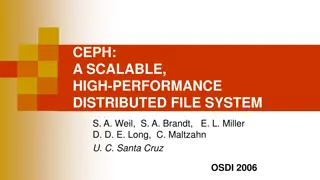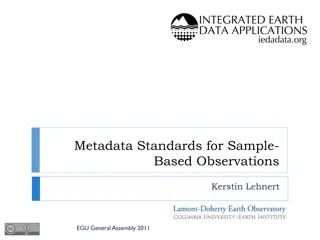Exploring Shelf Space Management Through Metadata Analysis
Delve into a novel approach of utilizing metadata such as number of pages, binding type, and year of publication to study shelf occupancy in libraries. The project focuses on addressing the challenge of accurately measuring shelf space taken up by library stock, proposing a data-driven model for better space management. Initial investigations, literature reviews, and data collection phases demonstrate a promising path towards a more efficient shelf space utilization strategy.
Download Presentation

Please find below an Image/Link to download the presentation.
The content on the website is provided AS IS for your information and personal use only. It may not be sold, licensed, or shared on other websites without obtaining consent from the author. Download presentation by click this link. If you encounter any issues during the download, it is possible that the publisher has removed the file from their server.
E N D
Presentation Transcript
Modelling shelf space with catalogue metadata Joe Nankivell, UCD Leabharlann UCD UCD Library An Col iste Ollscoile, Baile tha Cliath, Belfield, Baile tha Cliath 4, Eire University College Dublin, Belfield, Dublin 4, Ireland
The problem Space management: a recurring theme. But no detailed data on how much space our stock takes up. Two existing approaches: 1) Measure shelves (e.g. 2011 CONUL storage project) - difficult and time-consuming to obtain - zero granularity 2) Use a benchmarked average (e.g. 36 books/metre, SCONUL) - usually overestimates - no nuance MARC record doesn t include width if only!
Proposal Could the metadata give us any useful proxies? Number of pages Binding Any other factors? Year of publication Height Study the influence of these factors on shelf occupancy
Scoping and preliminaries Literature review: no work already done on this But Wootton (1977: 22) measured the thickness of 1,250 books: a starting point, 15 pages/mm. I conducted preliminary measurements of 20 shelves (c.800 items) Measured shelf occupancy in mm Scanned barcodes of all items on each shelf Downloaded MARC data for items Used Wootton figure to create a model OK, but not granular enough.
MARC 300 cleanup Convert text to data MARC 300 (subfield a) Total Pages 76p. 76 76 xviii, 342p. 360 360 ix, (1), cxxiii, 300 p., [6] plates 439 439 x, 426, A1-A26p. 462 462 xxvi,p309-584,[xv] 301 301 2v.(xx,964(i.e.965),(6)p,(10)leaves of plates ??? There again: 2v. ? ? 1 volume ? ?
Data collection, phase 2 Randomised selection of 100 shelves (3000+ items) Logged shelf details (location, occupancy in mm) Scanned every item on shelf, recording: Binding (cloth or paperback) Width in mm Height in cm Shelf ID Pulled catalogue data using scanned barcodes. Cleaned up MARC 300 Total granularity!
Dataset Gathered from shelves From catalogue, matched on barcode
Bookshelf visualiser Actual measurements
Bookshelf visualiser Estimated measurements
Bookshelf visualiser Compare estimate with true width
Bookshelf visualiser Identify problem areas in data 251mm thick, should be 24.6mm: Typo in MARC 300 Typo in MARC 300 Way oversized: formula fails with high pagination high pagination Way undersized: formula doesn t yet take volumes with no volumes with no pagination pagination into account
Try out the app to follow developments and view code: https://nankj.github.io/MARC-300-visualiser/ Thank you!
























